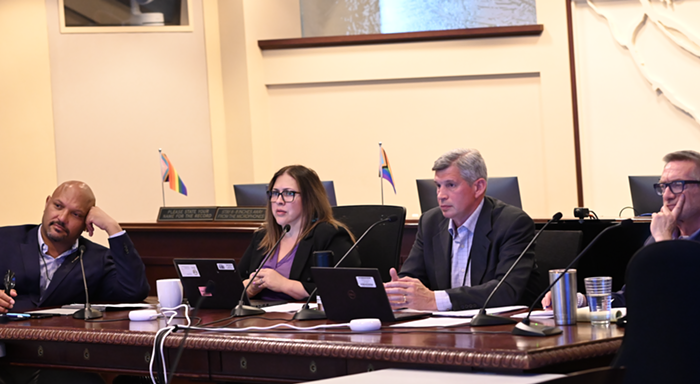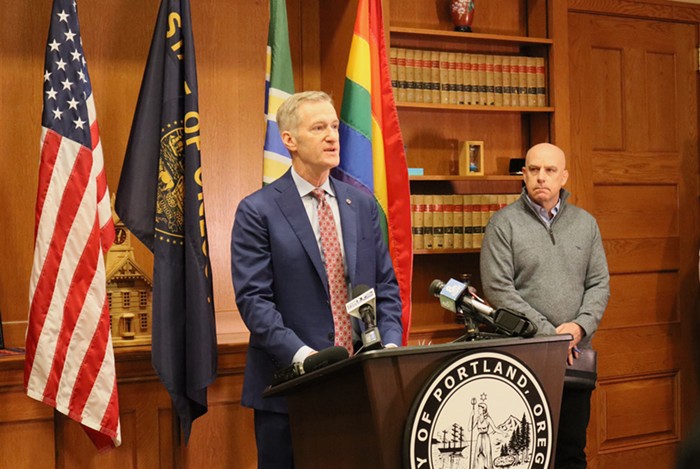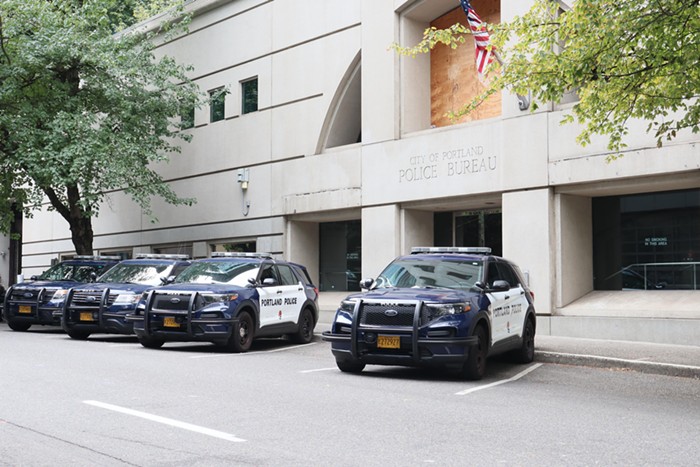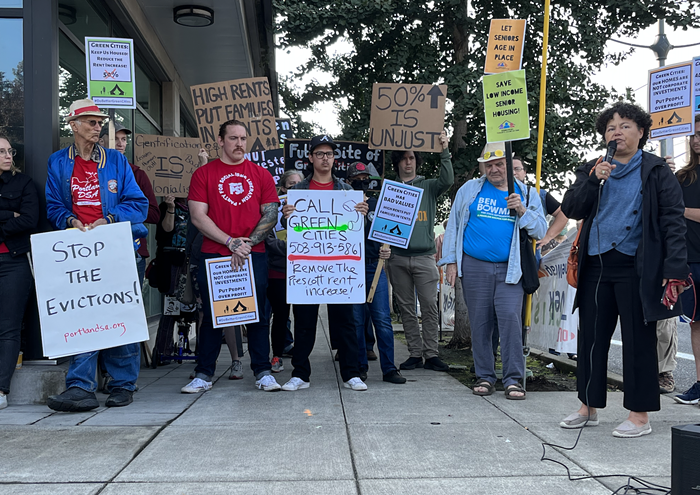"Yeah, I think I scare people," Zack (not his real name) says. He seems faintly proud of his ability to intimidate. When asked about perceptions of homeless youths in Portland, he shrugs his shoulders, as if to say, "Who cares?"
Later he admits, "I'm from Beaverton. I'm not homeless-- just bored."
THE FERAL GENERATION
Like most summers, with the rain clouds clear, the population of homeless youths downtown seems to blossom. And, attendant with the burgeoning population, is an increase in the volume of chatter from concerned citizens. Editorials in the Oregonian and business owners renew their complaints that the street youths pose a threat to shoppers and scare away business. It's a ritual as routine as the Rose Festival.
This year, popular Oregonian columnist S. Renee Mitchell led the pack with a pair of scathing editorials about street youths. In recent columns, such as one titled, "We Should Cater To Tourists Not Panhandlers," she wrote about how "hobo teens" and "dysfunctional youth" discourage tourism, business, and shopping downtown. Mitchell's columns joined other articles and TV news spots that almost invariably characterize street youth as a dark, menacing, and frighteningly mysterious population. The stereotype has become so prevalent in both the media and peoples' minds that it is taken by many as an established fact.
But what's disturbing is that the articles and news reports have little, if any, evidence to back them up. They are based on personal observations and fears, and on glib assumptions.
On a recent sunny weekday afternoon, Pioneer Square was packed with shoppers and street youths alike. A few clutches of teens--both truly homeless kids and teens pretending to be--were hanging out, panhandling. But, at that very same time, more homeless teens were actually indoors at one of the several agencies in town that work with street kids.
"Right now," said Ken Cowdery, Executive Director for New Avenues for Youth, "we have 45 [youth] preparing for their GEDs." A few blocks away from Pioneer Square, p:ear, a non-profit that teaches teens art skills, was packed with young people crowded elbow to elbow around art tables. Dozens of other homeless teens were picking up lunches or health services at the other social services agencies downtown.
"To have this broad brush portrayal," Cowdery says, "is not fair and very misleading." Cowdery explains there's a wide gulf between the perception of the threat that street youths present and the reality.
"People begin to think it's a police issue and a public safety problem," explains Cowdery. "To focus on violence... that's not fair, that's not right."
An hour before speaking with the Mercury, Cowdery had attended a meeting with other executive directors from downtown social service agencies to talk about the Mitchell columns and the public opinion about homeless youth.
"There's a perception that there is aggressive panhandling," Cowdery says. But referring to the consensus expressed at the meeting, Cowdery adds, "We all agree it's not happening that way."
Cowdery asserts that most of the aggressive panhandlers are not truly homeless youth, but bored teens from Beaverton and Hillsboro.
"The vast majority [of homeless youth] are attending school, programs and shelters," says Cowdery. "We know 95 percent of the homeless youth in town," he estimates. "We know our kids by name and face."
He goes on to explain, "You read this stuff and think that no one is doing anything and there are no services." Portland actually has one of the strongest networks of social services for youth in North America.
"Homeless kids [in Portland] don't need to panhandle," asserts Cowdery. "They have the services that they need."
THE MEDIA VS REALITY
Although Oregonian editorials bemoan the rising threat of street youth, in fact the reality is a much different story. Portland police were not able to provide specific data about whether street youth commit more or less crimes than other residents--but several national studies and surveys present a picture than differs from the popular image of violent street kids.
A recent Gallup Poll found that a majority of adults are under the impression that teens commit nearly half of all violent crimes in this country. Although that poll does not relate directly to street youth, it does provide a context for thinking about American misconceptions. In reality, according to FBI statistics, teens are only responsible for 13 percent of violent crimes--only one-third of what most frightened adults tend to believe.
The source of this prejudice? The media. According to a LA Times poll, 65 percent said they learned about crime through reading newspapers or watching TV news. This information is consistent with other polls and studies.
Interestingly, those media accounts--especially when relating to street youth--are either grossly exaggerated or patently misleading. Two social service agencies in San Francisco jointly monitored local news accounts about homeless youth. In total, there were 72 articles. Of those articles, almost three-quarters depicted street kids as criminals. Moreover, 50 articles--or, about two-thirds--did not bother to consider the root causes of youth crime, and 15 articles demanded increased policing and tougher criminal punishments for street youth. Not one single article researched if tougher penalties actually reduced crime.
In S. Renee Mitchell's Oregonian column, she based her assertions that street youth make tourists feel "unsafe" on observations from a friend visiting from out of town. She called these teens "foul-mouthed, menacing and brash." But there were no interviews with street youths and no references to crime stats. In spite of this lack of empirical data, Mitchell confidently asserted that street youth are a dangerous presence.
Instead, the truth is that, sadly, more often than not, these youths are the victims--not the perpetrators--of crimes. Most studies find consistent information about the family life and background for homeless teens: Roughly one-third of street youths have been sexually abused; more than one-half have been physically abused; and nearly two-thirds have simply been neglected.
This is not to say that Portland's homeless youths are angels one and all. Some do commit crimes. But the question remains whether those crimes actually equal the perceived threat.
In clinically bland language, this question was most succinctly answered at a national symposium on homeless youth in 1998. The report from that meeting concludes: "Many homeless adolescents report illegal behavior. However, some of this behavior may be part of their strategies for survival." The report goes on to explain that, according to homeless youth service providers across the country, the majority of crimes committed by street youth are tied to survival. The three most prevalent crimes, says the report, are breaking into a building for shelter, stealing, and selling drugs for money. But interestingly, the rate of larceny is nearly equivalent to the incidents of shoplifting for non-homeless teens.
A recent study in Los Angeles puts a finer point on this information. Interviewing hundreds of street youth, homeless advocates found that 46% of boys and 32% of girls take part in "survival sex." Of that group, 82% prostituted themselves for money, 48% for food or a place to stay, and a small group for drugs. A Hollywood study also found that half of the street youths sampled sold drugs. But interestingly, only one-fifth of that group--or, one in ten of all street youths--sold drugs to support their own habit. The rest sold drugs as a means to earn money for food or shelter.
WHO'S REALLY IN DANGER?
What is most dangerous about these misconceptions is that they form public opinion and, subsequently, guide public policy. Over the past few years, largely pushed by the Portland Business Alliance, city hall has fashioned a set of laws that allow police and business owners to combat "the menace of street youth." Two years ago, for example, with revisions to Title 14, mayor Vera Katz made it easier for officers to ticket anyone who is sitting, lying, or loitering on the streets downtown. According to street youths, officers routinely threaten them with tickets if they don't move along.
This spring, city council approved an ordinance that allows downtown business owners to sidestep zoning laws and place gates over their alcoves. The business owners had complained that homeless people were sleeping in their doorsteps and scaring away customers.
And, last year, when the so-called Exclusion Zones were ruled unconstitutional, city council immediately passed a slight revision to the rule. This allowed the law to tiptoe around those civil rights concerns, so they could once again be enforced. Under the exclusionary rules, a police officer may kick a person out of downtown on the mere suspicion of criminal activity. The officer does not need any concrete proof--just a perception that the teen is up to no good. According to anecdotal evidence from civil right attorneys, those laws have been directed unequally, and towards street youth in particular.
In Mitchell's column, she asserts that we should not feel sympathy, but fear. She calls the homeless youth "intimidating" and chastises Mayor Katz for not being sterner in dealing with these teens.
But perhaps it's not the businesspeople and shoppers who should be frightened by the street youth. After all, it's they who are being subjected to these stereotypes and unfounded prejudices--it's still the adults who hold the power. And it's adults who are leveling the laws and public opinions that are so unfairly tilted against them.


















